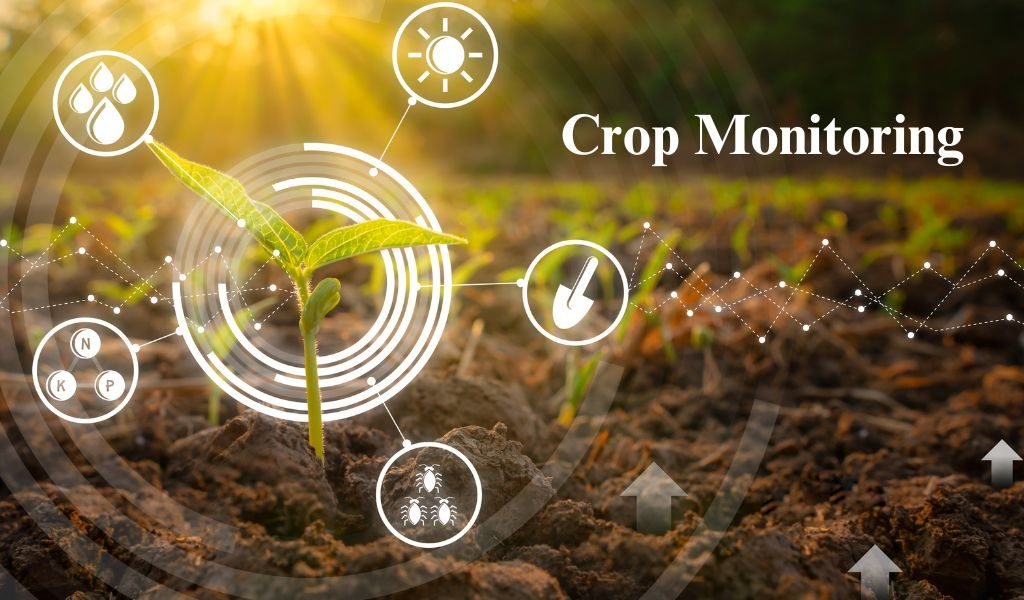Crop Monitoring
What is Crop Monitoring?
Crop monitoring means regularly checking your crops to see how they are growing and staying healthy. This helps farmers spot problems early and protect their crops better.
Also,
- Satellite images combined with drone data give better crop condition views.
- Government programs often support farmers in adopting crop monitoring tech.
- Using mobile apps and alerts makes it easier to stay updated from anywhere.
- Crop monitoring helps make farming smarter, more profitable, and sustainable for all farmers.
Read the next information and explore more helpful details on All about agriculture for better crop monitoring guidance and tips.

Methods of Crop Monitoring
- Visual Observation: Walk through fields and look closely at crops for any signs of problems.
- Remote Sensing: Use satellite or airplane images to see large farm areas and crop conditions.
- Soil Sensors: Place sensors in soil to measure moisture, temperature, and nutrients.
- Crop Sensors: Use special devices that check crop growth and health automatically.
- Drones: Fly drones with cameras and sensors to get detailed views of fields quickly.
Technologies Used in Crop Monitoring
- Artificial Intelligence (AI): AI helps analyze crop data to spot problems and make suggestions.
- Internet of Things (IoT): Smart devices like sensors and drones collect and send crop information.
- Geographic Information System (GIS): Mapping tools that visualize crop and field data clearly.
- Mobile Apps: Apps help farmers track crops, get alerts, and get expert advice on their phones.
Importance of Crop Monitoring
- Helps farmers spot pests, diseases, or nutrient problems early to reduce crop losses.
- Improves crop quality and yields by timely checking and managing crop needs.
- Saves money by using water, fertilizers, and pesticides only when needed.
- Supports sustainable farming by reducing waste and protecting the environment.
Benefits of Crop Monitoring
- Saves time and resources by focusing efforts only where needed.
- Improves decision-making with accurate, real-time crop information.
- Raises crop quality and market value by catching issues early.
- Helps protect the environment by reducing chemical use and water waste.
Challenges and Future Directions
- Managing large amounts of crop data from different sources can be difficult.
- Scaling crop monitoring to very big or diverse farms needs better tools.
- Combining crop monitoring with other practices like irrigation or fertilization is important.
- Training farmers to use new technology remains a key challenge.
- New tools like AI, drones, and IoT will continue improving crop monitoring.
Frequently Asked Questions
How can crop monitoring reduce pesticide use?
Crop monitoring helps identify pest problems early and only in affected areas. This targeted approach lowers pesticide use, saving money and protecting the environment.
What are multispectral images in crop monitoring?
Multispectral images capture different light wavelengths from plants, revealing hidden stress or disease before visible signs appear, helping farmers act quickly.
Can crop monitoring improve irrigation management?
Yes, it provides data on soil moisture and plant water stress, guiding farmers to irrigate only when needed, saving water and improving crop health.
How do drones enhance crop monitoring?
Drones fly over fields to capture detailed images and measure crop health quickly across large areas, allowing precise and timely farming decisions.
What role does AI play in crop monitoring?
Artificial Intelligence analyzes large amounts of crop data to detect patterns, predict problems, and suggest actions, making crop management easier and more efficient.
Are crop monitoring tools affordable for small farmers?
Many affordable mobile apps and sensor kits are now available, with government support making these technologies accessible for small and marginal farmers.
How often should crop monitoring be done?
Regular monitoring, weekly or biweekly during critical crop stages, helps catch issues early and ensures timely interventions to protect yields.
Can crop monitoring help with organic farming?
Yes, it enables organic farmers to track crop health and growth naturally, reducing the need for chemical inputs by timely spotting problems and managing them sustainably.
What is the difference between remote sensing and in-field monitoring?
Remote sensing uses satellites or drones for large-scale crop data, while in-field monitoring involves sensors and manual checks for detailed, localized information.
How does crop monitoring support sustainable agriculture?
By optimizing input use and reducing waste, crop monitoring helps maintain healthy soil, conserve water, and lower chemical runoff, promoting long-term farming sustainability.
Can crop monitoring detect nutrient deficiencies?
Yes, sensors and imaging technologies identify early signs of nutrient shortages, allowing farmers to apply fertilizers precisely and improve crop performance.
What future technologies might improve crop monitoring?
Emerging tech like blockchain for traceability, advanced AI predictive models, and integrated IoT networks will further enhance accuracy, transparency, and farm management efficiency.